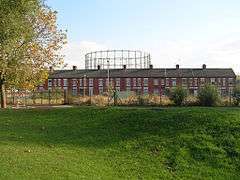Miles Platting
| Miles Platting | |
|---|---|
 A row of terraced houses in Miles Platting | |
 Miles Platting Miles Platting shown within Greater Manchester | |
| OS grid reference | SJ856992 |
| • London | 163 mi (262 km) SE |
| Metropolitan borough | |
| Metropolitan county | |
| Region | |
| Country | England |
| Sovereign state | United Kingdom |
| Post town | MANCHESTER |
| Postcode district | M40 |
| Dialling code | 0161 |
| Police | Greater Manchester |
| Fire | Greater Manchester |
| Ambulance | North West |
| EU Parliament | North West England |
| UK Parliament |
|
Miles Platting is an inner city part of Manchester, England, 1.4 miles (2.3 km) northeast of Manchester city centre along the Rochdale Canal and A62 road, bounded by Monsall, Collyhurst, Newton Heath, Bradford and Ancoats.
Historically part of Lancashire, and formerly a part of the township of Newton Heath, Miles Platting began to appear on maps in the 1820s, when it had begun to expand into a factory district as a result of the Industrial Revolution. That industrial growth resulted in a population that became very large for the size of the district, resulting in densely packed terraced housing that had degenerated into slums by 1950. As a result of this crime rose and the area became a economically deprived part of the city.
Miles Platting is part of the East Manchester Regeneration Scheme and is undergoing extensive redevelopment and regeneration as some of the last former slum terraces are removed to make way for more council housing.
History

The origin of the name remains uncertain, but one suggestion is that it may derive from the word platt, meaning a small piece of ground, with miles being a corruption of mills. Hence Miles Platting may mean "mills on a small piece of ground".
Miles Platting certainly did have many mills by the middle of the 19th century: Holland Mill, Victoria Mill and Ducie Mill were among the largest. By the 1870s a chemical works, timber yard, gas works and a tannery were also operating in the area alongside the many mills. This volume of industry in such a relatively small area inevitably led to the construction of densely packed back-to-back housing to provide homes for the necessary workforce. By the middle of the 20th century, with the decline in manufacturing industry and the closure of its local industries, Miles Platting had become a slum area inhabited by a deprived, lcommunity. Today, Miles Platting contains just under 2,000 housing units, many of them managed by Adactus Housing Association on behalf of Manchester City Council, including 12 multi-storey blocks.[1] The area, once recognised as being amongst the most deprived in the UK, has benefited from the substantial urban regeneration scheme for east Manchester initiated in the late 1990s.
Miles Platting railway station lay at the junction of the lines from Manchester Victoria to Oldham and Stalybridge, but this closed in 1995, and the station was subsequently demolished. The railway line, which remains open for passenger traffic, separates Miles Platting from Collyhurst and Monsall.
Between 1839 and 1844, the area was also the location of Oldham Road railway station, the original terminus for the Manchester and Leeds Railway until the line was extended to Manchester Victoria station in the latter year. The station was then converted to become a major railway goods depot by the Lancashire and Yorkshire Railway, remaining in use until the 1960s.
Governance
Miles Platting was incorporated into the City of Manchester in 1838.
Geography
Landmarks
A prominent building of Miles Platting is Victoria Mill, a huge former cotton mill that looms over the district and now houses offices and apartments. Its restoration was directed by Fr Dominic Kirkham of Corpus Christi.
Religion
Historically, much of the population of Miles Platting was of Irish Catholic or Italian descent, as evidenced by the large Corpus Christi Priory on Varley Street. The basilica has been served since 1889 by the Norbertine (Premonstratensian) Order, becoming an independent canonry of the order in 2004. Due to falling numbers and mounting repair and maintenance costs the basilica is now closed; the final Mass was celebrated by the Bishop of Salford on 27 April 2007. A significant Pakistani Muslim community now resides in the area and the basilica has been converted into the Usmania Banqueting Hall.[2]
From 1880 until the slum clearances of the 1970s there was a Salvation Army corps in Cash Street.
Miles Platting is in the Roman Catholic Diocese of Salford,[3] and the Anglican Diocese of Manchester.[4]
Transport
The majority of bus routes are operated by Stagecoach Manchester. Buses from the city centre include 74, 76, 76A. Bus route 77 offers two early morning journeys from Moston via Newton Heath. MCT also offers the 217 service from Shudehill Interchange to Ashton via Clayton.
References
- ↑ "Miles Platting". New East Manchester. Archived from the original on 19 May 2007. Retrieved 18 May 2007.
- ↑ "Basilica closes after 118 years". BBC. 27 April 2007. Retrieved 18 May 2007.
- ↑ "Catholic Diocese of Salford". Retrieved 7 May 2007.
- ↑ "The Church of England Diocese of Manchester". Archived from the original on 27 December 2007. Retrieved 7 May 2007.